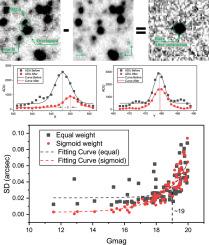2016-2021年利用盖亚DR3对六颗木卫二不规则卫星进行新的天体测量定位
IF 2.5
2区 物理与天体物理
Q2 ASTRONOMY & ASTROPHYSICS
引用次数: 0
摘要
木卫三系统就像一个微型太阳系,其质量是所有其他行星质量总和的两倍多,并且拥有许多天然卫星。它的形成和早期演化对我们了解太阳系的结构雕刻有着深远的影响。天体测量观测非常重要,根据这些观测,可以确定太阳系天体的轨道动力学,有时还可以确定其起源。我们的目标是获得一些不规则卫星 Elara、Pasiphae、Sinope、Lysithea、Carme 和 Ananke 的良好天体测量位置,以完善它们的轨道和星历表,并了解它们的动态。我们利用云南天文台丽江站的 2.4 米望远镜,历经 27 个夜晚,拍摄、处理并缩减了 2016 年至 2021 年期间的 964 幅地面 CCD 图像。在 CCD 图像处理中,采用了 ISIS 的图像减法技术,以剔除与 2019 年目标图像接近或/和几乎重叠的恒星图像。星表 Gaia DR3 用于天体测量校准,其中采用了加权方案来求解更精确的板块模型。所有目标的理论位置都是从法国天体物理和计算研究所(IMCCE)的星历表中获取的。结果显示,所有目标的位置残差(观测值减去计算值)的平均值(O - C)分别为-0′′.007(R.A.)和0′′.011(Dec.)。除了 "阿南克"(最暗卫星)的标准偏差约为0′′.08之外,其他卫星的标准偏差均为0′′.05。本文章由计算机程序翻译,如有差异,请以英文原文为准。

New astrometric positions for six Jovian irregular satellites using Gaia DR3 in 2016 — 2021
The Jovian system is like a miniature solar system, with the system being more than twice as massive as all the other planets combined and having many natural satellites. Its formation and early evolution had a profound influence on our knowledge of the sculpting of the architecture of the solar system. Astrometric observations are of importance, based on these observations, its orbital dynamics, as well as its origin sometimes, of a solar system object can be determined. We aimed to obtain good astrometric positions of some irregular satellites Elara, Pasiphae, Sinope, Lysithea, Carme and Ananke to refine their orbits and ephemerides, and to understand their dynamics. We have taken, processed and reduced 964 ground-based CCD frames obtained between 2016 and 2021 by the 2.4 m telescope at the Lijiang Station of Yunnan Observatory over 27 nights. Among CCD image processing, the image subtraction technique of ISIS is employed to eliminate star images that are close to or/and almost overlapped with those of our targets in 2019. The star catalog Gaia DR3 is utilized for astrometric calibration, in which a weight scheme is applied to solve more accurate plate model. For all targets, their theoretical positions are retrieved from the Institut de Mécanique Céleste et de Calcul des Éphémérides (IMCCE) ephemeris. Our results show the mean (O - C)s (observed minus computed) of the positional residuals of all targets are and in R.A. and Dec., respectively. Their corresponding standard deviations are about in each direction, except for Ananke (the faintest satellite) with its standard deviation about in each direction.
求助全文
通过发布文献求助,成功后即可免费获取论文全文。
去求助
来源期刊

Icarus
地学天文-天文与天体物理
CiteScore
6.30
自引率
18.80%
发文量
356
审稿时长
2-4 weeks
期刊介绍:
Icarus is devoted to the publication of original contributions in the field of Solar System studies. Manuscripts reporting the results of new research - observational, experimental, or theoretical - concerning the astronomy, geology, meteorology, physics, chemistry, biology, and other scientific aspects of our Solar System or extrasolar systems are welcome. The journal generally does not publish papers devoted exclusively to the Sun, the Earth, celestial mechanics, meteoritics, or astrophysics. Icarus does not publish papers that provide "improved" versions of Bode''s law, or other numerical relations, without a sound physical basis. Icarus does not publish meeting announcements or general notices. Reviews, historical papers, and manuscripts describing spacecraft instrumentation may be considered, but only with prior approval of the editor. An entire issue of the journal is occasionally devoted to a single subject, usually arising from a conference on the same topic. The language of publication is English. American or British usage is accepted, but not a mixture of these.
 求助内容:
求助内容: 应助结果提醒方式:
应助结果提醒方式:


